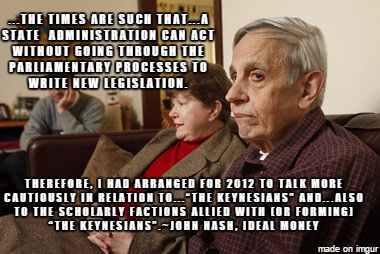Some Interesting notes from John Nash's Homepage
Some interesting notes from Nash's Homepage, this one on a program Nash wrote that searched for prime numbers:
Aug. 30, 1999 Initiation of this directory, "Goldbach_Programs". This is just for some recreational mathematics stuff that may be of occasional interest. I recently read the novel "Uncle Petros and the Goldbach Conjecture". In the story Petros, but at a time many years in the past, wonders about whether or not, in particular, the number 2^100 satisfies GB (so that it is a sum of 2 primes). Nowadays it is possible to compute answers to questions of this sort for numbers of that size fairly easily. As I read the novel and thought about that specific question I remembered that quite a few years ago, just while doing recreational work/play with numbers, I had developed a moderately efficient program to search for the next prime larger than a given odd number. And I realized that this program, which I had on file as a MATHEMATICA program, could be applied to the problem challenge of checking out 2^100 in relation to the Goldbach Conjecture.
And the admission of a project he was think about proposing:
I am speaking about a research project that is not fully complete since I have not yet written up and submitted for publication any paper or papers describing the work. Also the details of what axioms to use and how to select the basic set theory underlying the hierarchical extension to be constructed are not fully crystallized. I have also a great fear of possible error in studying topics in this area. It is not rare, historically, for systems to be proposed that are either inconsistent or that have unexpected weaknesses. So I feel that I must be cautious and proceed without rushing to a goal. And this psychology of fear has also inhibited me from consulting other persons expert in logic before I could feel that I had gotten my own ideas into good shape.
And perhaps relevant points from his works “Ideal Money”:
I think there is a good analogy to mathematical theories like, for example, “class field theory”. In mathematics a set of axioms can be taken as a foundation and then an area for theoretical study is brought into being. For example, if one set of axioms is specified and accepted we have the theory of rings while if another set of axioms is the foundation we have the theory of Moufang loops.
So, from a critical point of view, the theory of macro-economics of the Keynesians is like the theory of plane geometry without the axiom of Euclid that was classically called the “parallel postulate”. (It is an interesting fact in the history of science that there was a time, before the nineteenth century, when mathematicians were speculating that this axiom or postulate was not necessary, that it should be derivable from the others.)
So I feel that the macroeconomics of the Keynesians is comparable to a scientific study of a mathematical area which is carried out with an insufficient set of axioms. And the result is analogous to the situation in plane geometry, the plane does not need to be really flat and the area within a circle can expand hyperbolically as a function of the radius rather than merely with the square of the radius. (This picture suggests the pattern of inflation that can result in a country, over extended time periods, when there is continually a certain amount of gradual inflation.)
The last paragraph of which seems to be the most significant and relevant to bitcoin:
The missing axiom is simply an accepted axiom that the money being put into circulation by the central authorities should be so handled as to maintain, over long terms of time, a stable value.
